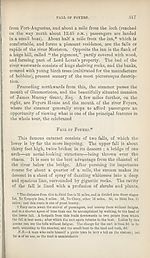Download files
Complete book:
Individual page:
Thumbnail gallery: Grid view | List view

516
OBAN TO INVEKNESS BY CALEDONIAN CANAL.
erected by the late Colonel Macdonell of Glengarry over the
“ well of seven heads,” commemorating the summary vengeance
inflicted by a former chief of Glengarry, “ in the swift course of
feudal justice,” on the perpetrators of the foul murder of the
Keppoch family. This eccentric chief was the original of the
character of Fergus M‘Ivor, who occupies such a prominent
place in the novel of Waverley. Near the mouth of the river
Garry, which discharges itself into this loch, are the ruins of
Invergarry Castle, the ancient gathering place of the clan Mac¬
donell. It was burnt in 1746 by the Duke of Cumberland.
Close to the ruins is the mansion of the Macdonells of Glen¬
garry, now a shooting-box of Lord Ward’s, who purchased
the Macdonell property in 1841, and who is proprietor of both
sides of the loch here. In front is a small islet with green
trees, and behind, a high mountain, called Craig an phitich, or
the Rock of the Raven, an appellation which formed the war-cry,
and is still the motto, of the chiefs of Glengarry. In passing
Glengarry Castle there is a beautiful view, looking south, of
Ben Feach (the mountain of the deer) and the range of moun¬
tains called Glengarry’s Bowling-green.
At Aberchalder (which is reached about 11.40 a.m.), the
steamboat descends to Fort-Augustus on Loch Ness, by eight
locks. The distance from the first to the eighth lock is two
miles, and this part of the way may be walked by those who
wish the exercise, as the steamer takes an hour and a quarter
to make its way through.
Fort-Augustus is situated at the south-western extremity
of Loch Ness, and close upon the edge of the water. It was
built shortly after the rebellion of 1715 in the form of a quad¬
rangle, with four bastions at the corners. The barracks contain
accommodation for about 300 men, and a company from a
Highland depot now garrison the place.
Loch Ness is nearly twenty-four miles in length, and
averages a mile and a quarter in breadth. In many places it
is of great depth—about 130 fathoms—and, from the uni¬
formity of temperature maintained by this depth of water, the
lake never freezes. The character of its scenery, though not
so varied and striking as that through which we have already
conducted the tourist, is particularly striking at a few points.
The first of these is at Invermoriston Inn, a short distance
OBAN TO INVEKNESS BY CALEDONIAN CANAL.
erected by the late Colonel Macdonell of Glengarry over the
“ well of seven heads,” commemorating the summary vengeance
inflicted by a former chief of Glengarry, “ in the swift course of
feudal justice,” on the perpetrators of the foul murder of the
Keppoch family. This eccentric chief was the original of the
character of Fergus M‘Ivor, who occupies such a prominent
place in the novel of Waverley. Near the mouth of the river
Garry, which discharges itself into this loch, are the ruins of
Invergarry Castle, the ancient gathering place of the clan Mac¬
donell. It was burnt in 1746 by the Duke of Cumberland.
Close to the ruins is the mansion of the Macdonells of Glen¬
garry, now a shooting-box of Lord Ward’s, who purchased
the Macdonell property in 1841, and who is proprietor of both
sides of the loch here. In front is a small islet with green
trees, and behind, a high mountain, called Craig an phitich, or
the Rock of the Raven, an appellation which formed the war-cry,
and is still the motto, of the chiefs of Glengarry. In passing
Glengarry Castle there is a beautiful view, looking south, of
Ben Feach (the mountain of the deer) and the range of moun¬
tains called Glengarry’s Bowling-green.
At Aberchalder (which is reached about 11.40 a.m.), the
steamboat descends to Fort-Augustus on Loch Ness, by eight
locks. The distance from the first to the eighth lock is two
miles, and this part of the way may be walked by those who
wish the exercise, as the steamer takes an hour and a quarter
to make its way through.
Fort-Augustus is situated at the south-western extremity
of Loch Ness, and close upon the edge of the water. It was
built shortly after the rebellion of 1715 in the form of a quad¬
rangle, with four bastions at the corners. The barracks contain
accommodation for about 300 men, and a company from a
Highland depot now garrison the place.
Loch Ness is nearly twenty-four miles in length, and
averages a mile and a quarter in breadth. In many places it
is of great depth—about 130 fathoms—and, from the uni¬
formity of temperature maintained by this depth of water, the
lake never freezes. The character of its scenery, though not
so varied and striking as that through which we have already
conducted the tourist, is particularly striking at a few points.
The first of these is at Invermoriston Inn, a short distance
Set display mode to:
![]() Universal Viewer |
Universal Viewer | ![]() Mirador |
Large image | Transcription
Mirador |
Large image | Transcription
| Antiquarian books of Scotland > Scotland/Scots > Black's picturesque tourist of Scotland > (648) |
|---|
| Permanent URL | https://digital.nls.uk/130035966 |
|---|
| Description | Thousands of printed books from the Antiquarian Books of Scotland collection which dates from 1641 to the 1980s. The collection consists of 14,800 books which were published in Scotland or have a Scottish connection, e.g. through the author, printer or owner. Subjects covered include sport, education, diseases, adventure, occupations, Jacobites, politics and religion. Among the 29 languages represented are English, Gaelic, Italian, French, Russian and Swedish. |
|---|

